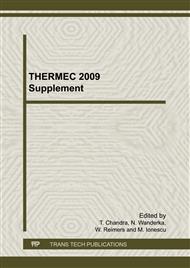p.285
p.290
p.295
p.301
p.307
p.313
p.319
p.325
p.331
Phase Constitution and Mechanical Property of Ti-Cr and Ti-Cr-Sn Alloys Containing 3D Transition Metal Elements
Abstract:
Effects of 3d transition metal element additions on phase constitution at room temperature and mechanical properties of Ti-Cr and Ti-Cr-Sn alloys were investigated in this study. Ti-5Cr and Ti-5Cr-3Sn (in mol%) alloys with or without 3mol% of 3d-transition-metals of V, Mn, Fe, Co and Ni were investigated. X-ray diffraction analysis showed that Ti-5Cr binary and Ti-5Cr-3Sn ternary alloys consisted of α' (hcp) and β (bcc) two phases, and the others were β single phase. Then, the additions of the 3d transition metals stabilize phase. The results were in good agreement with optical microscopy observation. Vickers hardness tests revealed hardening occurred by the additional elements, and the hardening must be mainly due to solid solution hardening. Besides, the hardness was lowered by 3mol%Sn addition. Tensile tests revealed that the additions of Fe, Co and Ni improve strength while V and Mn improve ductility.
Info:
Periodical:
Pages:
307-312
Citation:
Online since:
January 2010
Keywords:
Price:
Сopyright:
© 2010 Trans Tech Publications Ltd. All Rights Reserved
Share:
Citation:


